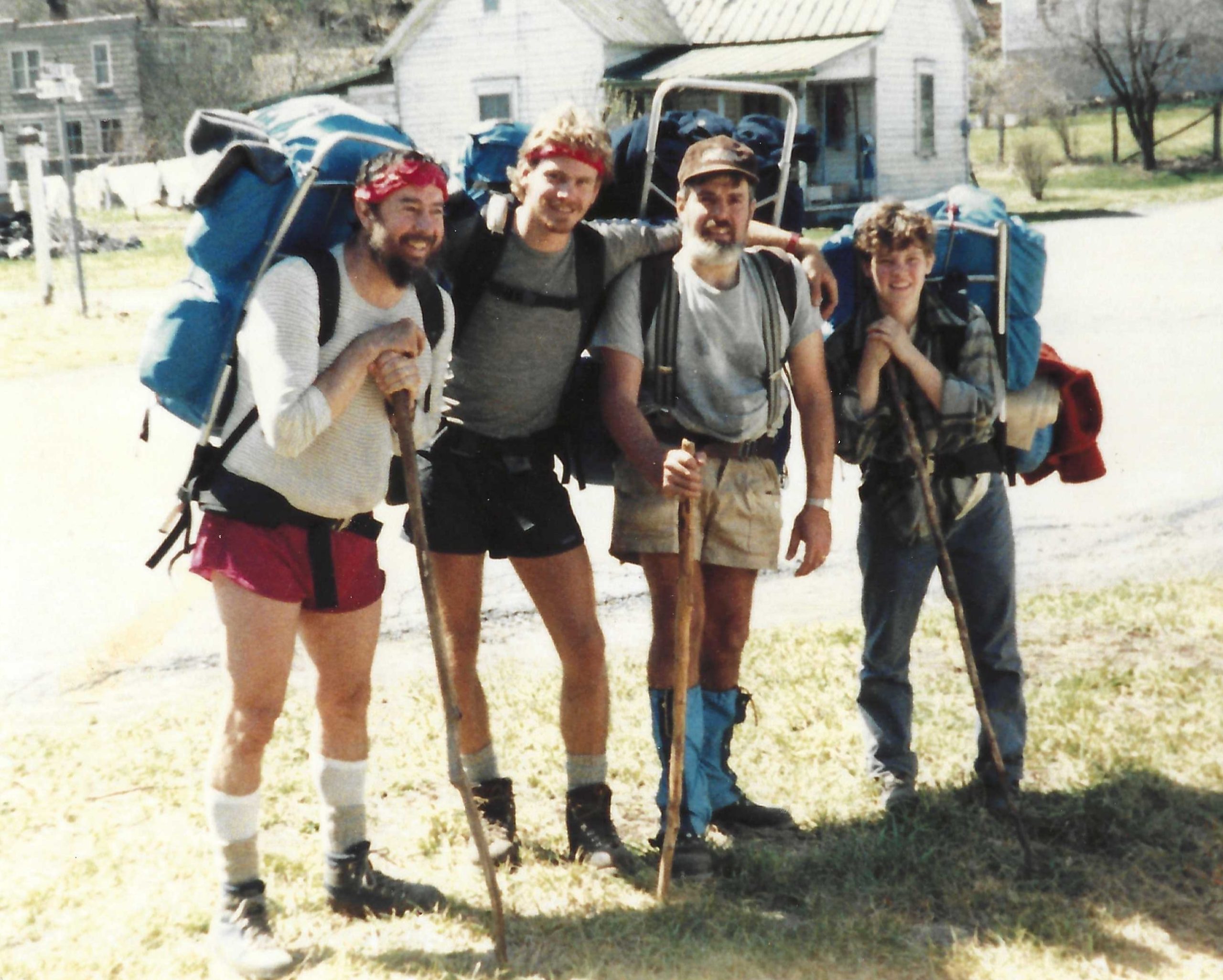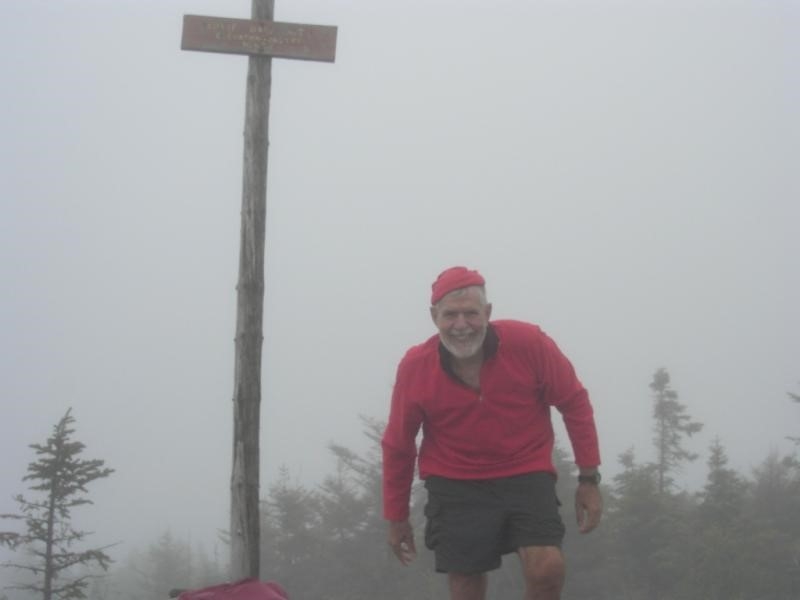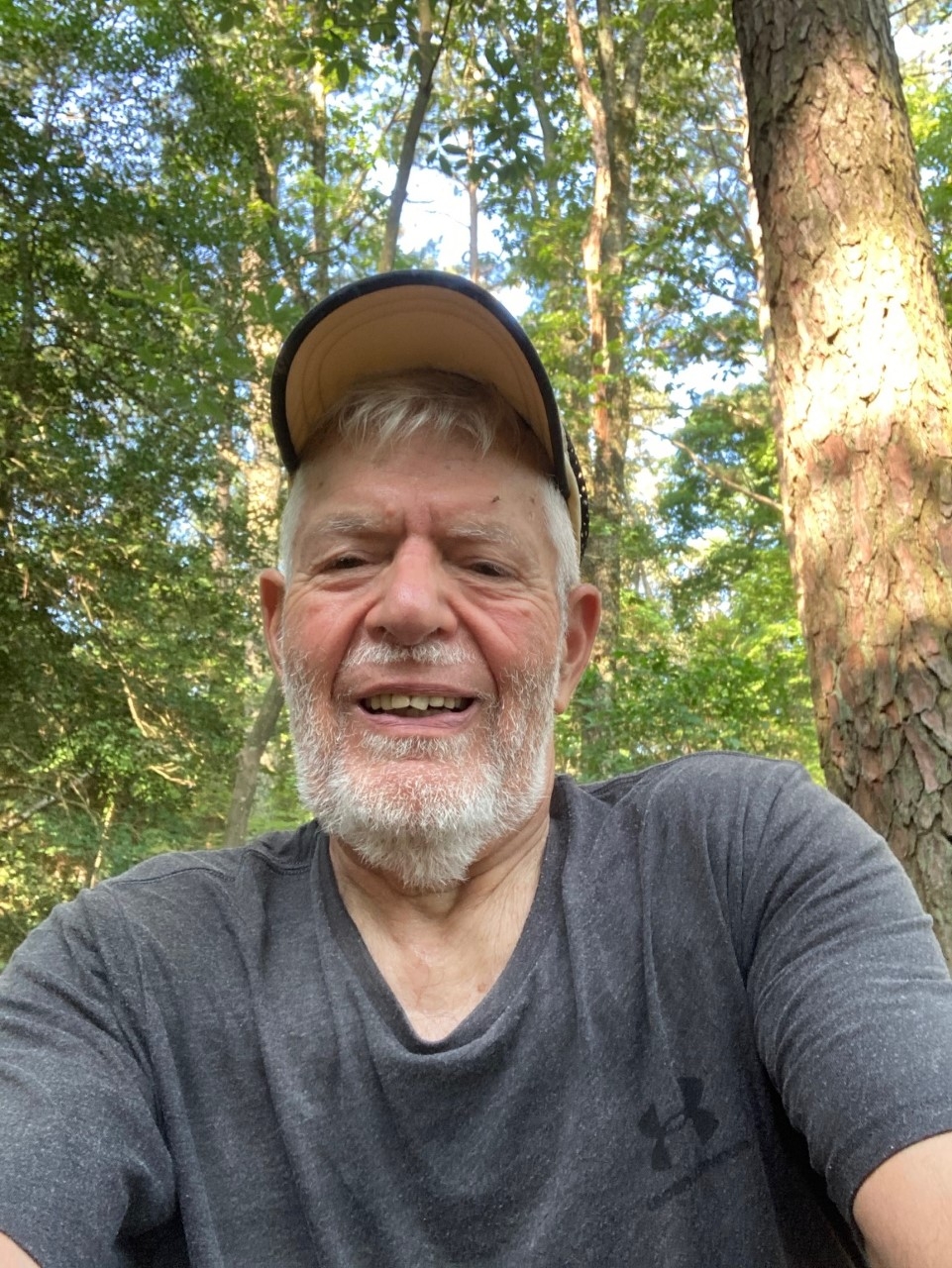Professor Hardcore’s 28-Year Appalachian Trail Section Hike
My AT section hike began in 1975 with an impulsive and poorly planned climb up Katahdin on the Hunt Trail with my two younger brothers and my 11-year-old daughter. Twenty-eight years later, in November of 2003, a week before going into Johns Hopkins Hospital to have my severe spine curvature stabilized by titanium rods, I finished my last two uncompleted sections: two miles near Swatara Gap and the Delaware River Bridge. This was to be my third spine surgery for post-polio scoliosis. The first two were done in 1957 and 58 with bone slivers from my tibias. The first two fusions lasted for the whole trail. The slivers had become four inches thick by the time the surgeon cut them away.
But this guest post is not just about my AT hike. It is about my whole life: my plaguey sense of post-polio inferiority, conflicts with my Lutheran minister father and subsequent male authority figures, overcharged Horne libido, and later struggles to be a good teacher and at the same time a writer. I grew up thinking myself an unathletic nerd, but my love for the wild and, later, the wilderness helped me move beyond my narcissism. In time, I would become an outdoor recreation leader, guiding and inspiring my students to love Nature.
Professor Hardcore’s Learning Curve
My learning curve as a hiker was a slow one involving constant equipment adjustments and upgrades. My learning curve as a human was equally tortuous, involving a wayward adolescence, a competitive temperament as an English faculty member flailing for advancement later in life, and eventually, a streak of meanness and testiness, partially caused by physical pain but also just my Horne temperament.
At Gettysburg College (1960-64), I had small successes publishing short stories. One of my classmates, Jerry Spinelli, would go on to achieve major fame with such stories as Maniac Magee. Jerry was also from Norristown, PA, and we both wrote about growing up in that former mill town on the Schuylkill River with its funky, hot pepper ethnic sauce of Blacks and Sicilians.
I spent my boyhood and early teen years playing dangerously on the tops of roofs in my congested neighborhood as a substitute for rock climbing. My father’s church was on Dekalb Street, formerly route 202 north. Tractor trailers climbing the hill always downshifted under my window. Untrammeled wilderness was not to be found amidst the Post Office, the County Court House and Jail, and the Borough Hall and Market.
After I got married at age 21 and entered graduate school at Penn (1964-68), advancement in my field of English required that I give up creative writing for scholarly research and publication. I did publish two books and numerous articles and presented my share of papers. But the urge to write creatively was not fully suppressed. My lectures often tended to be free-association improvisations. After fully retiring from teaching in 2009, I realized I had lost my identity as a full professor and Graduate Director in English. This sent me into a tailspin from which I have slowly recovered by writing my autobiography, which centers on the Appalachian Trail.

Horne on a spring break trip to the AT near Damascus, VA with Joe Gilbert and students from Salisbury University in 1986.
From the Year 2525
Why write a seven-volume autobiography covering sixty-three years about a twenty-eight-year section hike? Hiking the AT has been chronicled by a multitude in all sorts of print and digital media. Seminal books include Earl Schaffer’s Walking with Spring, Ben Montgomery’s Grandma Gatewood’s Walk, and Bryson’s semi-fictional bestseller A Walk in the Woods. On the web, we have Trail Journals, White Blaze, The Trek, and YouTube, among others. A few have started their coverage with their pre-trail life, one or two reaching all the way back to their childhood.
But no one has used their hike as the organizing idea for a 1200 page-digital-fully illustrated-meta tragicomic epic with an apocalyptic science fiction framing and three fictive narrators, each with his own font color. Blame this overkill on the pretentious retired English professor. My android narrator (#1) is actually a humatron with learning capabilities. As my superego, his semi-comic editing leads me to atonement for pretention, hurtfulness, and self-centeredness.
At the same, there is messaging in my sci-fi framing that extends beyond me. My autobiography is entitled Professor Hardcore’s Learning Curve: Back to the Wild from 2525. It is set in a colony on Titan (a moon of Saturn) in the year 2525. “The colony is small, with a total population of 500,000. It was established shortly before earth was made uninhabitable by the nuclear wars of the twenty-second century. These were followed by successive holocausts brought about by one viral pandemic after another, global die offs which were exacerbated by catastrophic climate change. The earth colony on Titan is contained in a number of interconnected huge bubbles (biodomes), and a nature is artificially created as a fabricated (ingenious but artificial) approximation of temperate zone earthy locale” (1). ”
Readers familiar with the works of Orwell, Huxley, and Vonnegut will pick up my dystopia as satire on some of the catastrophic directions in which our twenty-first century seems headed. My second narrator forbodes world events for each decade from the forties through the aughts. He focuses on the degradation of our environment, especially climate change.
NOLS and Beyond
My strongly developed wilderness ethic, which I owe to my NOLS training, underlies my fiction. In the early 80s, I was drawn West to do peak ascents in the Rockies with my brother Tom. Around the same time, I was mentored by an ex-Marine and former Boy Scout leader who taught me how to do straight-line AT hiking and also promoted me as Advisor of SSC’s Outdoor Club and Freshman Orientation in the Wilderness in Algonquin Provincial Park. This led to my NOLS course in Montana’s Beartooth Mountains in 1985. In the midst of this, I was still preparing for class, sitting at my desk to mark essays, and then sitting even longer to write a study of Restoration and Eighteenth-Century Marriage Poetry. All of which was making my spinal curvature worse.
Annually, I was cranking out three trips a semester with the Outdoor Club, including weekend AT hikes in the Middle Atlantic, a twelve-day ski trip in the Laurentians, caving, and top-roping. Over spring break, I hiked longer sections of the southern AT with faculty partners, and in summer I hiked sections of the northern AT with student partners and a group from Salisbury called the Eastern Shore Mountain Goats (hut-to-hut in the Whites). At the end of each summer (20 total), I was back canoe tripping in Algonquin, leading another trail crew of seven newbies and one experienced peer counselor (often a repeat from a previous year).
In 1992, I did Outward Bound in Colorado in the Collegiates. After placing my book on Marriage Poetry with University of Georgia Press in 1993, I quixotically undertook a project on Arctic narratives. Pursuing this, I survived two major trips to the sub-Arctic and the Arctic: in 1994, an extended traverse of the Auyuittuq Peninsula on Baffin Island, and in 1996, a month-long trip to Alaska where I visited Denali, the Inupiat island Kaktovic on the North Slope, the Gwich’in Arctic Village, and did a partially aborted canoe trip on the Noatak above the Brooks Range. The Alaska trip was, in part, a crusade to oppose drilling in the 1002 area of the ANWR.
Completing the Appalachian Trail Over 28 Years
Meanwhile, by 1997, I had section-hiked a little more than half of the AT. That year over spring break, I was given my trail name, Professor Hardcore. This was at a campsite overlooking Burkes Garden after surviving a severe thunderstorm under my tarp. Giving up on the idea of more ambitious peak ascents out West and downsizing my Arctic narrative project, I committed then, almost in default, to finishing as a LASHER (long-ass section hiker). My curvature was getting progressively worse, and the pain from it was making me testy and petulant, a prickly pear of a hiking partner.
Between 1997 and my second spine surgery with titanium rods in November of 2003, I completed all my remaining trail mileage (about 1000). Shortly before my surgery, my scoliosis had progressed to 110 degrees; I was doing shorter sections more frequently with more pain. The quad in my right leg was atrophying due to a pinched nerve. In 1992, I fell in the Hundred Mile Wilderness near Bodfish Farm and had to be evacuated by Blackhawk helicopter. Then later that same summer, still hurting, I did a 250-mile canoe trip with Class 3 and 4 rapids down the Coppermine River in NWT and then Algonquin again. The following year, I hiked three difficult sections in NH and ME, including the section where I fell.
I only finished the trail with the forbearance of my hiking partners and especially my wife and family. I went through three Salisbury University faculty and staff, three partners I located on the internet, and numerous groups of loyal students, especially a couple who were NOLS alumni. My relationship with all of them and with myself is a central dynamic of my autobio. Each now has his/her due, as does my father.
Post-surgery, two painful hikes taught me that my titanium rods did not lend themselves to carrying a heavy pack for long distances. Yet I still had good functionality paddling a canoe and a kayak, and I was still able to cross-country ski with a day pack. I went back to McGill House in Quebec several times and also to the Laurel Highlands in PA. I did a number of challenging kayak trips, two in Parry Sound, one on the north shore of Lake Superior, and another in Glacier Bay, Alaska. Then, there were three whitewater canoe trips with Black Feather on rivers that run from the Canadian Shield south into the Ottawa River: the Dumoine twice and the Noire once. Most recently in the Maritimes with Coastal Adventures, an epic in Trinity Bay, Newfoundland, and One Hundred Wild Islands out of Tangier.

Horne stands at the summit of Moxie Bald, ME in 2003, nearing the end of his 28-year section hike. Photo by Jeff McClaflin.
Now at age 80, I do Nordic Track while watching AT hikers on Youtube. The trail is still the same trail with the same icons. But there are more hostels, shuttles, and trail angels than I remember. When I started section hiking, I was averse to spending any money for lodging. However, after 2000, I did more motels and hotels, even The White Hart Inn in Salisbury, CT.
In contrast, some Youtube posters get shuttled to a hostel seemingly every other night. They also frequently skip filming some sections, especially the difficult ones like Lehigh Gap. I was meticulous in covering every hike and even supplied an Appendix of cumulative miles organized by milepost interval. There are more stealth sites than I remember and am willing to condone; there are also more “bubbles” (a new term). Electronic devices make for a brave new world filled with Phones/cameras, GPS/PLBs, battery banks, charging blocks, and tripods. I rented a cell phone once and worried about roaming charges. When I finally did buy a cell, it no doubt saved my life after my fall.
Since I seem now only to be day hiking, the Youtube videos have become a life-saving connection to the AT as well. The thing about being a section hiker for twenty-eight years is that I never really left the trail. When I was out there hiking, it seemed like I’d always been out there, and when I got back on the trail after a time away from it, I acknowledged its eternal presence.
“Yes, here we are again on the trail and it is the same as it always has been. How could I have forgotten that this is where I belong and this is what nourishes me, even though it is often painful.”
When I thought about the possibility of losing the connection with the trail’s wildness and beauty, I would assure myself that I could always go out and find it again. So, writing about it when I was hiking was not an obligation. Why try to write about something that is so much better and more real than any words can convey?
Now that I am not hiking the AT, the reality of it returns only partially when I rehearse my hikes. But I still feel its eternal presence—the rocks, the roots, the blowdowns, the mud, the rain, the wind, the sun—the trail’s sameness and incredible diversity.
About the Author
Faculty Emeritus William C. Horne (aka Professor Hardcore) retired fully in 2009 after teaching 36 years at Salisbury University in MD and, previous to that, four years at the University of Michigan-Flint. He received his Ph.D. from the University of Pennsylvania in 1971 and his BA from Gettysburg College in 1964. Now 80 years old, he has been married to Susan since 1963 and has two children (Shelley and David) and four grandchildren. At Salisbury University, he was advisor of the Outdoor Club for 22 years and a faculty trail crew leader in the Algonquin Freshman Orientation in the Wilderness for 20 summers. Since retirement, he has played euphonium in several bands and brass ensembles and sung in the University Chorale. In 2003 he completed a 28-year section hike of the AT.
Featured image by James Hatley.
This website contains affiliate links, which means The Trek may receive a percentage of any product or service you purchase using the links in the articles or advertisements. The buyer pays the same price as they would otherwise, and your purchase helps to support The Trek's ongoing goal to serve you quality backpacking advice and information. Thanks for your support!
To learn more, please visit the About This Site page.







Comments 3
Seagull Power! I believe you led trips in 1980-1981 with my younger brother and numerous friends, one of whom I will be aiming to NOBO the AT in 2024 (an another who, after celebrating a bit too much, ended up sleeping under his tent). Good luck with the book (sounds interesting), what a journey you have had. Thank you!
Terrific read! Spent my life serving in the military & just started my Thru-hike in July out of Harpers Ferry NOBO. Only made 650+ this year because my 58 yr old knees & ankles crying “Uncle” lol. Articles like yours have eased my tensions of admitting there is no way I will probably complete this journey in 12 months without doing more harm than good to my body. Look forward to the book! Thank-you
My memory fails me on the exact name, but I remember reading a lot of “insane” shelter journal entries from a professor in 2008 that seemed to ramble incoherently and have a lot of beefs with an Oklahoma Boy or some midwestern phantom who we also never met.
The consensus among the people I was hiking with was that this mystery writer was indeed a lunatic and we all desperately wondered who they were and if we’d meet them at Trail Days. No dice. If this nutty professor wasn’t you, my apologies.